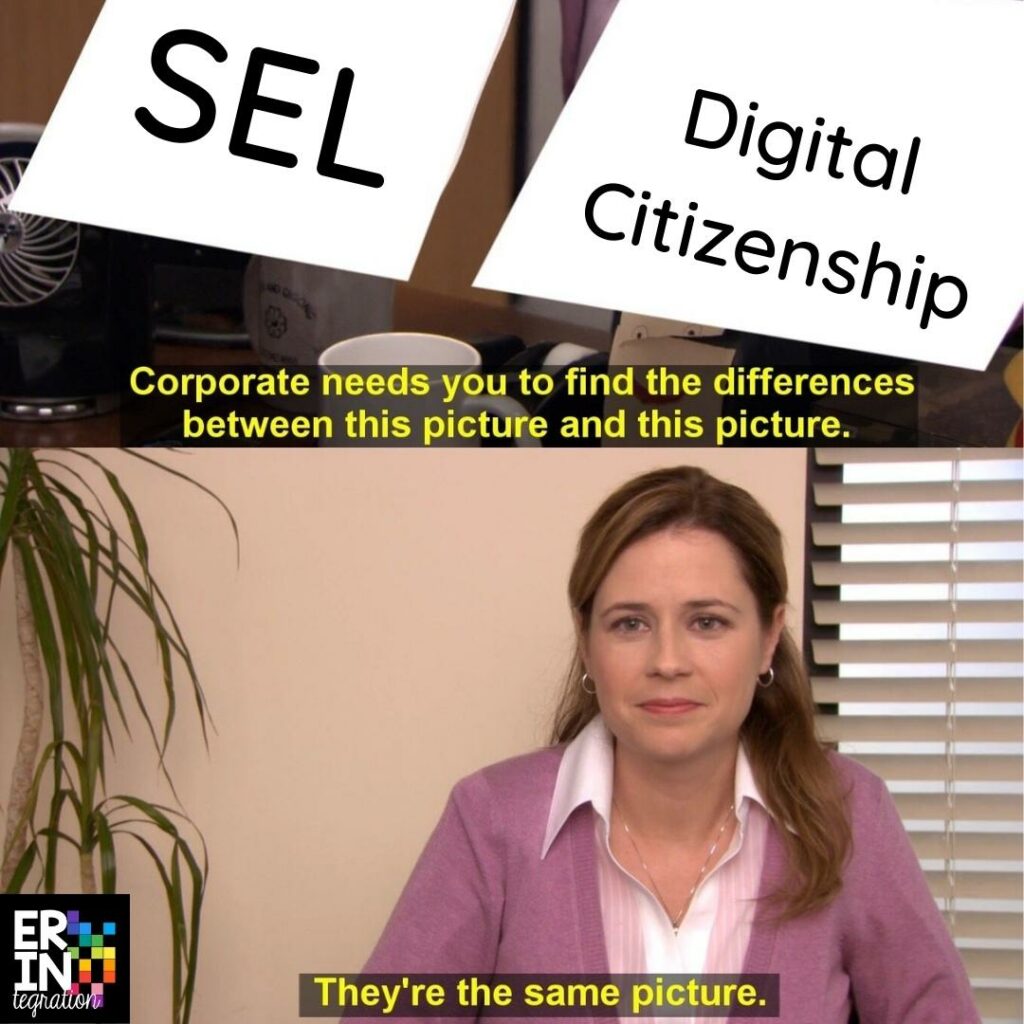There is a popular meme with a screenshot of Pam from the Office looking at two images and saying “It’s the same picture.” I’m reminded of that meme when SEL became the buzzword of 2021 and 2022 because as someone passionate about the teaching of digital citizenship, SEL and digital citizenship: it’s the same picture.

What is SEL?
SEL refers to social-emotional learning and the teaching of soft skills associated with it. “After” the pandemic, many schools adopted various frameworks such as the CASEL 5 core competencies:
- Self-Awareness
- Self-Management
- Social Awareness
- Relationship Skills
- Responsible Decision-Making
and/or those put forth by the RULER approach in experiencing and managing emotions:
- recognizing
- understanding
- labeling
- expressing
- regulating
But even without a formal curriculum or training, elementary teachers are teaching SEL skills whether they planned to or not pre, during, and post-pandemic. The main shift is really the creation of SEL as a subject area separate from the core subjects. So while you might have addressed SEL in your classroom management or even via any character study lessons or rubrics assessing how learners “felt” about their learning, many teachers are now setting aside time to specifically teach SEL.
While the buzziness and eager adoption of SEL as a “thing” sometimes can make teachers wary, I definitely believe addressing social-emotional skills is important regardless of the current on-trend way to package it.
SEL and Digital Citizenship
This brings me to the post of this post. For children growing up now, the line is incredibly blurred between real life and digital life. While us elders remember a time “pre-digital” and have experiences untouched and outside of online spaces, kids and young adults don’t. Even kids NOT online or on social media are impacted by it.
For a quick and light-hearted example, my 3rd-grade daughters (who are not on social media and do not have access to YouTube) asked me about the “Corn Song” every student and teacher seemed to know. They even had a teacher incorporate corn into a lesson due to the viral video’s popularity. And that was their first experience of being “left out” digitally and then “left out” IRL by not getting the reference.
Truly not a big deal for them, but extrapolate that experience to group messages, photo sharing, social media commenting, “online” popularly…and it makes for a very real experience that mostly happens in the virtual world.
Therefore, if you are addressing SEL in the classroom, it needs to include a digital lens – not as a whole separate lesson – but integrated into the SEL curriculum, approach, goals, and activities.
Resources for Authentically Connecting Social-Emotional Learning and Digital Citizenship
The key word here is authentic. CASEL and Common Sense Media got together to chat about this topic and shared some important data and points. You can watch the session here:
Common Sense Media, a favorite digital citizenship curriculum of mine, has a free resource to help teachers use the framework of SEL to guide digital citizenship discussions.
Get the free Guide to SEL and Digital Citizenship here.
Each of the lessons in the guide opens with a “digital dilemma” that lends itself to class discussion. Guided discussion questions are included to help students dig deeper.
NOTE: I would not use some of the dilemmas in the guide as stand-alone lessons – mostly because some of the dilemmas refer to underlining racism and sexism that aren’t addressed in the questions at all. These would work better when integrated into a larger social justice / digital citizenship approach. As with any scenario where students are discussing sensitive topics, tread lightly and consider how some students might not feel safe.
However, what I love about the guide is how each lesson is organized. Taking an SEL dilemma and framework but integrating online life is more meaningful and realistic for the students you are working with. Learn more about the Common Sense approach to SEL here.
Carrie Rogers-Whitehead, CEO and Founder of Digital Respons-Ability, wrote a blog post here with some great ways to connect SEL with Digital Citizenship by focusing on:
- Ability to transition
- Critical thinking
- Digital Empathy
- Self-regulation
I love the focus on empathy especially as that is an area I do not see enough of in digital citizenship activities. We focus so much on protecting data and protecting our safety, but not enough on how our online behaviors impact others.
Instead of always focusing on the “bad” side – the trolling, the bullying, etc. we should be sure to give students specific tools for spreading the love online too!
Digital Citizenship is SEL
SEL is the process through which all young people and adults acquire and apply the knowledge, skills, and attitudes to develop healthy identities, manage emotions and achieve personal and collective goals, feel and show empathy for others, establish and maintain supportive relationships, and make responsible and caring decisions.
CASEL https://casel.org/fundamentals-of-sel/
In addition to developing their identities in the real world, students need to consider how they “behave” when online, how it is different, and how to better connect their two “selves” in a safe way.
Are you addressing SEL and digital citizenship in the classroom at the same time? Let me know what you think and join the conversation on Instagram.
